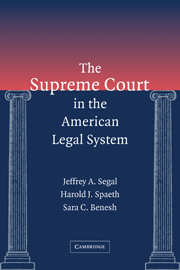Book contents
- Frontmatter
- Contents
- List of Illustrations
- List of Tables
- Preface
- I INTRODUCTION
- 1 Judicial Policy Making
- 2 Approaches to Judicial Decision Making
- 3 The Supreme Court in American Legal History
- II JUDICIAL PROCESS
- III LOWER COURTS IN THE AMERICAN LEGAL SYSTEM
- IV THE SUPREME COURT
- V IMPACT
- Case Index
- General Index
3 - The Supreme Court in American Legal History
Published online by Cambridge University Press: 05 June 2012
- Frontmatter
- Contents
- List of Illustrations
- List of Tables
- Preface
- I INTRODUCTION
- 1 Judicial Policy Making
- 2 Approaches to Judicial Decision Making
- 3 The Supreme Court in American Legal History
- II JUDICIAL PROCESS
- III LOWER COURTS IN THE AMERICAN LEGAL SYSTEM
- IV THE SUPREME COURT
- V IMPACT
- Case Index
- General Index
Summary
We explained in Chapter 1 why courts in our constitutional system – especially the Supreme Court – have such authoritative policy-making capability and how the powerful Supreme Court makes decisions. In this chapter, we will illustrate manifestations of this capability that have occurred over the course of our history.
BEFORE THE CONSTITUTION
When colonists arrived to settle the New World, they carried from England their heritage, their customs, and their law. English law was predominantly judge-made law. This judge-made law evolved out of local customs that helped local judges decide local disputes. As royal authority grew, Henry II (1154–1189) established royal courts that could issue decisions in the king's name. This structure ultimately required consistent rules throughout the land. Some local customs were dropped, and others spread. Those that survived became the customs common to all England and formally became known as the common law.
As in England, statutory authority grew in the New World. The Massachusetts Body of Liberties, adopted in 1641, was New England's first legal code. While establishing a Christian state, the code also guarded against the deprivation of life, liberty, and property “unlesse it be by vertue or equitie of some expresse law;” protected the citizens' “Immunities and priveledges;” and guaranteed to all residents, “whether Inhabitant or forreiner,” “the same justice and law.” Torture was prohibited for the purpose of obtaining confessions but could nevertheless be used after conviction in order to obtain the names of coconspirators, but only if the torture was not “Barbarous and inhumane.”
- Type
- Chapter
- Information
- The Supreme Court in the American Legal System , pp. 41 - 72Publisher: Cambridge University PressPrint publication year: 2005



